2020 February
2018 December August June February
2017 December September June March
2016 November August June March
2015 December October July May February
2014 December October July April February
2013 December October August May February
2012 December September July April February
2011 December September July April February
from the July, 2015 issue of Kiai!
We Break to Strengthen:
Why Thousand Waves Teaches Board Breaking to Children
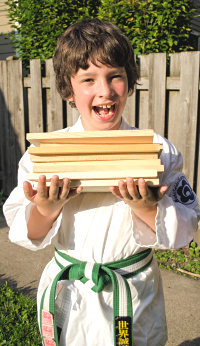
Henry Lamitie with his stack of broken
boards.
Karate Parent and Green Belt
My son, Henry and I have been members of Thousand Waves for a few years. We have been aware of the tameshiwari (board breaking) workshops, but life seemed to keep us busy when the workshops were scheduled. In February this year, we were able to let Henry attend a tameshiwari workshop – he was eight at the time. As a parent, it is difficult to view my child not as the baby I remember. The thought of letting him smash parts of his body into wood filled me with dread: “Will his hands break? He’s still growing! Why do we do this stuff?! He really wants to try this but he’s my baby!” Henry and I love our time at Thousand Waves, but parental instincts and fears are powerful things. In the end, we allowed him to go, he had a great time, learned important things and he broke a few boards.
I recently asked him about his experience with board breaking:
Chris Lamitie: “Do you remember what your first break was?”
Henry Lamitie: “My first break was a downward hammer fist.”
CL: “Did you break it on the first try?”
HL: “I broke it on the first try. It was fun. Jun Shihan Sarah held the board. We were only breaking the half inch boards, not the inch boards.”
CL: “Did you want to break more boards after that? “
HL: “Yeah, I broke 4 boards.”
— Sei Shihan Nancy Lanoue
HL: “Yes. Three practice [strikes] is the limit. And then when you say ‘osu!’ to your senpai or sensei, you do the break you’re going to do.”
CL: “Did you think you were ready to break?”
HL: “Yes, I felt I was ready to break.”
CL: “Were you scared?”
HL: “I was a bit nervous, but not very scared.”
CL: “We’re you afraid you wouldn’t break a board?”
HL: “You’re always afraid … you might not break it. Then I just calm my mind, empty it of all thoughts and think about the board. Thinking about breaking a board.”
CL: “Did breaking hurt?”
HL: “It stung for a few seconds, but didn’t hurt very much.”
CL: “Do you remember your other techniques?”
HL: “My other techniques were stomp-kick and roundhouse elbow.”
CL: “How did you feel after you broke the board?”
HL: “I felt good. I felt happy. I was happy I broke the board.”
CL: “How to do you feel about Thousand Waves and how they taught you to break and how they presented the workshop?”
HL: “They were very nice about it. They didn’t put you under a lot of pressure. I felt kind of scared, but a little more safe, that I wasn’t attacking a real person. I felt safer knowing I was breaking a board, not a bone. “
CL: “As a karateka, why do you break?”
HL: “We break to strengthen… it’s an exercise … we are trying to break the board and get to our highest effort.”
![]()
I myself have not had the opportunity to break, but Henry’s thoughts about his breaking experience intrigued me. I asked Sei Shihan Nancy if she had time to talk to me about breaking in the children’s program. She did, and here is what Sei Shihan Nancy had to say.
Chris Lamitie: “Sei Shihan Nancy, why do we break boards?”
Sei Shihan Nancy Lanoue: “I certainly can’t speak for all karateka ... but in Seido Karate, breaking is a traditional part of the practice. Kaicho includes it because it’s a unique way of challenging ourselves – different from how we do in basics, in kata or in sparring. Because in breaking, it’s much more independent practice. Your teacher cannot break the board for you, you have to break it yourself. The other thing is, it’s something that 99% of the people who do it, are afraid of on some level. So that makes it a good thing from a karate point of view because karate is about looking at fear, realizing the way it can stop us, and developing the ability to push against it. To try to push through it in some cases where it’s safe to do that. It’s a good test of technique ... it changes your relationship to virtually every technique you break with – that you understand a punch different after you’ve broken a board. You understand your spinning hook kick in a different way. It’s just plain fun, it’s very empowering ... it’s a historical part of our art.“
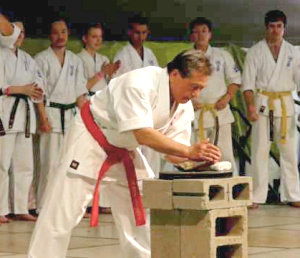
Kaicho demonstrates an advanced break.
NL: “… He’s talking about independence. Yes, I can coach you, I can critique you, I can tell you what you need to change in your technique to make it work, but you’ve got to put your fist or your foot through the board. It’s your spirit, your technique, your determination that makes it happen. That’s what makes it so “zen-like” and empowering for individuals. In a different way than going to a class, where, yes you do the hard work but your teachers are really also doing a lot of hard work to give you that experience and to shape that class. But in breaking it’s more about you, ‘the breaker.’ That’s what Kaicho meant, I think. “
“It’s not a hundred moves, it’s one move. It’s in one piece and you want it to be in two pieces. That’s one of the hardest things to learn. People will wind up (pauses) then hit! Wind up… and hit. They have to learn, of course, that it is one motion. You can’t get ready to kick, then kick. That’s a very advanced break, actually, to do it that way. The first way to break is, you’re standing there and you kick and the board is broken… or not. One motion.”
CL: “What was your first break?”
NL: “I’m very atypical in that it’s not the way Thousand Waves students’ first break will be. My first break was at a karate demonstration that Kaicho took us to. I signed up to be part of the demonstration and suddenly it was breaking time. And I don’t think Kaicho even knew I’d never broken and he just said ‘here it is.’ I said ‘… do what technique?’ I can’t even remember if it was a knife hand or a punch or whatever, but Kaicho said ‘break the board’ and I broke the board.”
CL: “How did you feel?”
NL: “Amazing! I felt invincible, I felt so strong. I felt surprised and kind of delighted that it worked. As everyone feels when they break their first board.”
CL: “You’ve probably broken a lot of boards since then ... why do you still continue to break?”
NL: “I still continue to break because I’m a martial artist. And I think the essence of being a martial artist is that you prove yourself every night or day you step on the training floor. Nobody cares, nor does it matter a wick what I could do 20 years ago, or 10 years ago, or yesterday. It’s whether I still have the courage to step on the floor and take that challenge on today. ... But I still have a flutter of nerves if I am in a room with all my students and we’re all breaking… it’s nerve wracking. Will they break? I don’t know. I think it’s my duty as the teacher to put myself on the line and try.”
CL: “Breaking is inherently dangerous, what techniques must be applied to correctly mitigate the risk of injury?”
NL: “The way we handle that in our dojo is we’ve thoroughly analyzed all the techniques that students know for their relative risk of injury and we’ve identified a group of techniques that we consider to be the least risky. Meaning, even if you don’t break [the board], it’s the least likely to cause any injury, or bruising or certainly anything worse than bruising. So beginners only work with those techniques. So you graduate from those techniques to more difficult techniques. Once you’ve broken single boards with all your basic techniques, only then do you begin to think about: ‘maybe I’ll try two boards with spacers.’ Then you take away the spacers and you do two boards without the spacers. So it’s a step-by-step, gradually increasing, degrees of difficulty. That’s one thing that keeps it safe.”
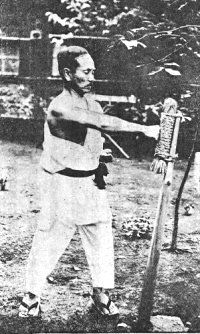
Funakoshi Sensei training on a
makiwara.
CL: “I was looking at a picture of Funakoshi Sensei using a makiwara that was, basically a stick in the ground with rope wrapped around it. I’ve read that’s another method … it offers less resistance and you are punching through the target.”
NL: “You mean the one that gives?”
CL: “Yes.”
NL: “The coaching that all beginner breakers receive is focused on what you said. You have to position the student such that they can go through the material, because, left to their own devices, they will line up – if it was a punch, for example ... they would naturally line themselves up so that at the end of the technique their hand is on the edge of the board. Of course, it can’t break if the technique is finished at the edge of the board. So the role of the coaches is to continually move the students forward. Sometimes we’ll have them practice stomping on the board to see how bent their arm or leg is, then we’ll move the board and go: ‘now do your technique.’ And they’ll see what it visually looks like to go how far through the board their hand will go. We say things like: ‘punch me right in the stomach. You won’t hurt me, but try to reach.’ They think ‘that’s impossible! There’s a board in the way.’ But when you go through the board, then your technique does end up going there. So that’s a very important part: ‘going through.’”
CL: “Why does Thousand Waves invite children to break?”
NL: “We invite children to break because we invite them to undertake the complete art. We are teaching them the full art of Seido Karate to all our students. In different ways, in age appropriate ways – considerations are taken into account. We want them to have that thrill of accomplishment, empowerment that I felt breaking my first board. We want them to suffer the agony of defeat and not give up – to figure out a way to keep working on it until they succeed.”
“Now the ability to allow children to break used to be very minimal because the only boards that were available were the type of boards that adults break with. Beginning about five years ago, I found a source in Vermont that takes a pine board of the one inch variety ... and they plane them in half, so they’re half of that thickness. Then they cut them in all different lengths. I can order them in the standard ten inch length or a six inch length. So, my littlest kids, the youngest youth students, some of them are only six or seven years old, are using these very thin boards, they’re smaller in size. And the thinner boards are … a comparable challenge to giving an adult a full size board. That really opened up the possibility of allowing more children to explore breaking, when we were able to get these boards.”
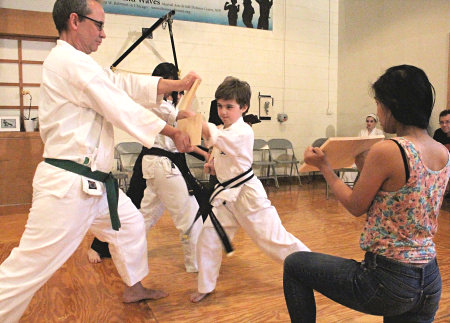
Senpai Evan Burleigh breaks a board with a palm heel strike.
“The first time we did it, I had no idea how it would work. I was a nervous wreck. I wasn’t sure if people would be injured. I did my homework to try to make it as safe as possible. We picked a very narrow range of techniques for them to try with. We worked diligently with them on target pads to hone their technique and coach them on the mechanics of breaking, of generating power. It was a big success! I think everybody was able to break something. Many people broke some, but not all. To me that was the perfect outcome. And we’ve continued to do it ever since that time. For those families that want it. We include it as a requirement at very high ranking, junior black belt tests. That’s when it becomes mandatory to try. Before that time it’s all optional, and many people like to do it.”
CL: “What is Thousand Waves strategy to help children break? What safety protocols do you have?”
NL: “We limit the number of people who can take the workshop to what we think we absolutely have enough skilled adult coaches to be able to supervise safely. We only have the most experienced teachers running the top level, and the next most experienced teachers are all serving as coaches. We set up small groups of kids with adult coaches. That has seemed to work well to keep everybody engaged and focused. And have them get a chance to both try to break, and to learn to hold, to be part of a team – celebrate other people breaking. We give them a very narrow range of techniques to work with and we ask them frequently ‘what have you broken with so far’ and ‘your next breaks could be a, b, and c.’”
“In the last breaking workshop we had a young teen, he’s 12, he’s a junior black belt, very gung ho for a karateka, very skilled breaker; he breaks up a storm… single boards. He’s broken with every technique he knows how to do, a single adult sized board with no trouble, no injuries. He finally convinced me to let him do two boards with a spacer in the last workshop. And he broke it fine, with no problem. I looked over at his team and he was trying to convince his coach to let him do two boards without a spacer, because he’s done it with a spacer, so that is the next step up for him. I walked over and said ‘I’m sorry, you are twelve, your bones are still growing, it is the logical next step but you have to gain 25 more pounds. You have to be bigger before I would consider that to be a healthy challenge for you.’ And he was disappointed but his mother and father were ‘Thank you!’”
CL: “It’s tough for kids to hear: ‘you’re not big enough yet.’ It’s hard for them to wait, when they want to go.”
NL: “Yeah, it is.”
CL: “What would you say to parents who were apprehensive about allowing their children to break?”
NL: “I would say, ‘don’t do it then.’ The parents have to trust the process feels safe to them. I would not try to talk any parent who is apprehensive into letting their child break … to convince them to enroll into a workshop. I would tell them ... [what] my experience has been breaking with children. I’d give them honest answers. Until they got to junior black belt test. And then I say: ‘It’s supposed to be hard.’ Martial arts does carry some risks, as does any other sport that you’re going to do. This is a big step your child is taking.”
CL: “Some break successfully, some don’t. What do the children learn from their success and failure attempting to break a board?”
NL: “So many things. I’ll try to give a concrete example: a young youth student, whose body mastery is only slowly emerging. This is a student was attempting to break with me in the breaking workshop. Much of what breaking is, on a technical level, is transferring weight and power and force. It involves pivoting, it involves alignment, it involves weight shifting. These are subtle and somewhat complicated physical concepts. This child had none of them. The first attempts in the target pad were very clear there was no way this break was going to happen, because the weight wasn’t going in the right direction, there was no weapon formed and so we worked with him on little target pads. One-on-one coaching and he did a hundred versions of roundhouse elbow, the technique he was trying to break with. Gradually he could strike with the proper weapon. He could transfer his weight with a pivot and use the strength of his legs to push down into the floor. And it got stronger and stronger and stronger on my target pad. Finally I put the pad down and picked up the board and I said: ‘You’re going to do the exact same thing.’ He was able to that and it broke! To me it was a profoundly technical learning experience for him. That’s one thing that somebody learned. He now understands pivoting and weight shifting and weapon formation in a more sophisticated way.”
CL: “How did he react when he broke the board?”
NL: “He was in a state of shock. He burst into tears. He was so surprised that it worked. He was so emotional, wanting it to work, but he got it together real quick. It was a very transformative moment for him.”
“I had a student in the last workshop ... trying to break, a teen, and her technique in the target pad was fierce and strong and great. When it became time to hit the board, she pulled her technique and didn’t go through the technique.”
CL: “What do you think happened there?”
NL: “Its fear. She knew it was fear. I had to say, ‘you’re not going to break today with this technique, because this fear is still really an obstacle for you. But you understand what it is, it’s more concrete for you now, that’s the issue. It’s not that you can’t hit something hard, it’s that this fear is stopping you. And, you’re going to get through that, but it’s not going to happen today.’ She ended up breaking with another technique we pull out of our hat when we can’t have anything else work. The famous stomp kick. To help people not feel hopelessly disappointed if they’ve had no other success. So this student worked on her stomp kick. She saw that, yes, her foot will go through the board. It didn’t hurt. It was fine. She understands more about fear. So that’s a really important lesson she got from failure. I honestly think there are lessons from both, from success and failure.”
“If everybody broke all the boards, it would be a little suspicious, wouldn’t it? ‘Are we really that great? Do the boards ever win?’ [laughs] So, I’m always very happy when some of the boards don’t break.”
CL: “How many breaking workshops does Thousand Waves host in a year?”
NL: “We generally do two for the children, and generally two for the adults. We spread them out in the annual calendar. We publish them in our annual calendar of offerings. If you want to pay attention to those things, come January when you get your calendar, you can make a note of when they are and try to align your availability for one of them.”
Thousand Waves hosts board breaking workshops so that karateka have a safe and controlled place to confront fear and learn to, literally, break through obstacles. Also, to taste the joys of victory and the agonies of failure. There is no instruction we can take to learn these things. Tameshiwari can lead a karateka to that point, but only the karateka can break through the fear. Tameshiwari teaches how we handle obstacles and how we handle removing, or not removing them. It is a life lesson on the most basic and fundamental level. Confronting the board is to confront and know your own character. There are few opportunities in life for such experiences.
![]()
I am happy I allowed my son to attend the workshop. That day of breaking for Henry was a great milestone. He is that that age where being independent is very important to him. Confronting the board, alone, was something only he could do. Despite the fact that he was in a noisy room full of people, surrounded by his friends, teachers and family, it still came down to him and the board. He had a wonderful time and is looking forward to the next workshop. He has asked if we could acquire a re-breakable practice board for home. I have to make it to the next adult workshop, so if anything, I can learn how to hold a board for Henry. I have a feeling he will be doing this for a long time.
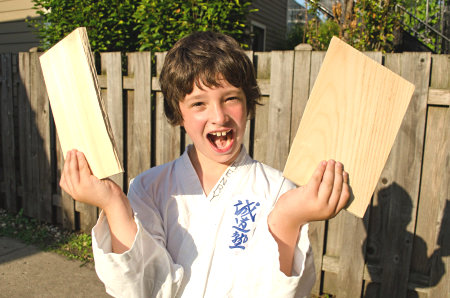
Henry Lamitie poses with two halves of a board that he broke.
The next board breaking workshop for kids is Saturday, August 15 from 4-5:30 pm. Cost is $25.
Register here or at Thousand Waves.
The next board breaking workshop for adults is Saturday, October 31, and costs $25.
